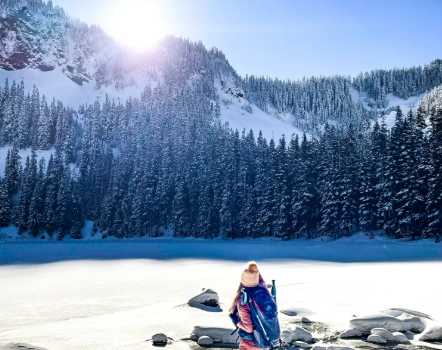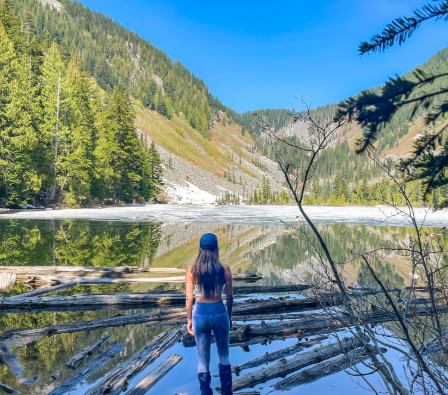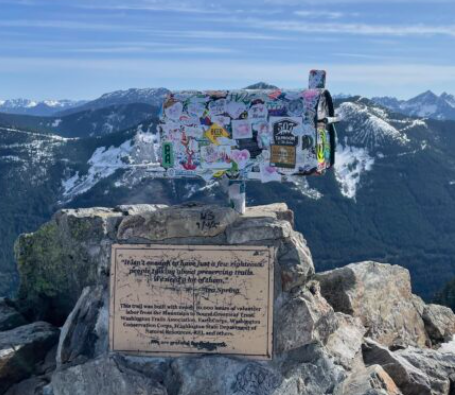
If you’re looking for a winter hike close to Seattle, Annette Lake is a fantastic option. This 7.5-mile trail offers a moderate to challenging hike with beautiful views, but it can become tricky during the colder months, especially with snow. In this guide, I’ll walk you through the experience, share tips, and give advice for making the most of your hike to Annette Lake, particularly in winter.
Trail Overview
Annette Lake is located just off the I-90 corridor, making it an easily accessible trail for those near Seattle. It’s a moderately difficult hike under normal conditions, but it can be quite challenging in winter. With an elevation gain of about 1,900 feet, the trail provides a good workout. The area around the lake is stunning, with panoramic views of the surrounding mountains and the nearby Hood Canal. Despite being a popular trail, it remains a serene spot to enjoy nature.
The Hike
As we arrived at the trailhead, we encountered a snowy forest road, making it tough to reach the parking lot. Luckily, we were only about a quarter-mile away, so we parked on the side and walked the extra distance. Starting the official trail, we crossed a beautiful log bridge that spanned a creek, which was running with fresh mountain water and surrounded by vibrant moss.
The hike begins with a steady incline, passing under power lines and into the woods. After about two miles, the trail becomes steeper, with several switchbacks that really start to get your heart pumping. As we progressed, we crossed several avalanche chutes, where the snow was packed enough to navigate but still required careful attention.
Avalanche Chutes
The first few avalanche chutes were straightforward, and we moved across them with relative ease. But when we reached the third chute, it started to get a little more dangerous. The snow was soft, and we started sinking with each step. Deciding it was better to be safe than sorry, we turned around before attempting the fourth chute. The snow had become too unstable, and one of us was already waist-deep in snow.
Although the lake was just half a mile away, we felt it was time to turn back. If even one person in your group feels unsafe, it’s important to call it. We turned around, and the trek back was slippery as the snow softened under the midday sun. Despite the falls and slips, we made it back to the starting point safely.
On our way down, we heard the unmistakable sound of an avalanche—a loud “whoosh” from a distance. We paused to listen and saw no signs of impact. However, we later heard another longer “whoosh,” which was a bit unsettling. It seemed to come from the opposite side of the trail, but we were still cautious. Sadly, we saw other hikers continuing toward the lake, many without proper gear. It was a reminder of how dangerous the mountains can be when you’re not fully prepared.
After our hike, we treated ourselves to a well-deserved beer with a view of the mountains. It wasn’t the perfect hike, but it was still a memorable one, and nothing hits the spot like a cookie and hot chocolate from North Bend Bakery to wrap up the day.
Winter Hiking Tips for Annette Lake
- Bring extra socks: The trail gets muddy, and even waterproof shoes won’t keep your feet dry. Having dry socks waiting in the car will make you appreciate the little things after a wet hike.
- Hike early: Snow conditions change quickly. As the day warms up, the snow becomes slushier, making it harder to maintain traction.
- Have a backup plan: Winter hiking requires flexibility. It’s essential to talk with your hiking partner(s) beforehand and decide what to do if conditions become unsafe or if you don’t make it to the lake.
Preparing for Your Hike
Even if you’re a seasoned hiker, it’s always a good idea to be prepared. Here are some tips for gear and planning:
Gear Recommendations:
- Microspikes: These are a must for winter hiking. They’ll help you maintain traction on icy or packed snow.
- Trekking Poles: These provide stability, especially on uneven and slippery surfaces.
- Gloves and Layers: Temperatures can change quickly. I always pack a down jacket and gloves for warmth, and layers are key to staying comfortable.
- First-aid kit & Headlamp: Always be prepared for the unexpected. It’s better to have them and not need them than the opposite.
Plan for Snow and Winter Conditions:
- Avalanche Warnings: Before heading out, check the NW Avalanche Center website for up-to-date information on avalanche risks in the Snoqualmie Pass area.
- Weather Updates: Expect snow-covered trails in winter and early spring. Be sure to dress for the conditions, and pack snow gear when necessary.
- Road Conditions: The trailhead is close to the interstate, but snowy roads can make driving difficult in the winter months. If the parking lot is inaccessible, you may need to park on the road and walk to the trailhead.
- GPS & Maps: Trails are more difficult to find under a blanket of snow, so download a map to your phone or bring a hard copy. Tools like AllTrails are great for offline navigation.
Safety First:
- Tell Someone: Always inform a friend or family member of your hiking plans, especially in winter when conditions can be unpredictable. Safety should always come first.
- Know Your Limits: Winter hiking can be more challenging than expected, so it’s important to assess whether it’s safe to continue if the conditions worsen.
Annette Lake is a fantastic winter hike with some breathtaking views, but it’s crucial to be prepared for all that nature throws your way. Whether you make it all the way to the lake or turn back early, remember that safety is the top priority. Happy hiking!








